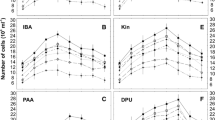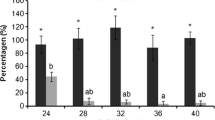Abstract
Urea at 200 ppm (probably serving as a nitrogen source), liquid Bold’s basal medium at pH 7.5, temperature of about 22 °C and light intensity of about 40 µmol m−2 s−1 for 16 h a day induced rapid and/or abundant zoospores formation and zoosporangia dehiscence and favored zoospore liberation, speed and motility time period in the green algaRhizoclonium hieroglyphicum. However, factors such as water stress (2 and 4 % agarized media, liquid media with 0.2–0.4 mol/L NaCl, 5–60 min blot-dryness of filaments), pH extremes of liquid media (at ≤6.5 and ≥9.5), temperature shock in liquid media (5 and 35 °C for ≥5 min), UV exposure (0.96–3.84 kJ/m2), lack of all nutrients from liquid medium (double distilled water), darkness, and presence of “heavy” metals (1–25 ppm Cu, Fe, Zn, Hg, Ni, Co) or organic substances (200–600 ppm captan or DDT, 800 and 1000 ppm 2,4-D, 50 and 400 ppm indole-3-acetic acid (3-IAA), 1000 and 2000 ppm urea, 100 and 200 ppm thiourea) in liquid media decreased and/or delayed at various levels either zoosporangia survival, zoospore formation or zoosporangia dehiscence and/or the rate of zoospore liberation from zoosporangia, zoospore speed and time period of motility in the media or totally inhibited all these processes. 3-IAA at 50 and 400 ppm induced zoosporangial papilla to grow into a tube-like projection of about 30–120 µm in length. Zoosporangial dehiscence rather than zoospore formation or zoosporangia survival, and zoospore motility period rather than zoospore speed are probably more sensitive to various adverse environmental factors. The rate of zoospores liberation from zoosporangium (possibly related directly to some extent on the zoospore number inside) is probably independent of zoospore speed in the medium.
Similar content being viewed by others
References
Agrawal S.C.: Effects of some factors on the zoospore formation inStigeoclonium pascheri (Vischer)Cox andBold.Phykos 32, 47–49 (1993).
Agrawal S.C., Misra U.: Vegetative survival, akinete and zoosporangium formation and germination in some selected algae as affectted by nutrients, pH, metals, and pesticides.Folia Microbiol.47, 527–534 (2002).
Agrawal S.C., Pal U.: Viability of dried vegetative cells or filaments, survivability and/or reproduction under water and light stress, and following heat and UV exposure in some blue-green and green algae.Folia Microbiol.48, 501–509 (2003).
Agrawal S.C., Singh V.: Viability of dried vegetative cells and the formation and germination of reproductive structures inPithophora oedogonia, Cladophora glomerata andRhizoclonium hieroglyphicum under water stress.Folia Microbiol.44, 63–70 (1999).
Agrawal S.C., Singh V.: Vegetative survival, akinete formation and germination in three blue-green algae and one green alga in relation to light intensity, temperature, heat shock and UV exposure.Folia Microbiol. 45, 439–446 (2000).
Agrawal S.C., Singh V.: Viability of dried cells, and survivability and reproduction under water stress, low light, heat, and UV exposure inChlorella vulgaris.Israel J.Plant Sci. 49, 27–32 (2001).
Agrawal S.C., Singh V.: Viability of dried filaments, survivability and reproduction under water stress, survivability following heat and UV exposure inLyngbya martensiana, Oscillatoria agardhii, Nostoc calcicola, Hormidium fluitans, Spirogyra sp. andVaucheria geminata.Folia Microbiol.47, 61–67 (2002).
Bold H.C.: The life history and cytology ofProtosiphon botryoides.Bull.Torrey Bot.Club 60, 241–300 (1933).
Burkholder P.R.: Movement in theCyanophyceae. The effect of pH upon movement inOscillatoria.J.Gen.Physiol. 16, 875–881 (1933).
Chen K., Feng H., Zhang M., Wang X.: Nitric oxide alleviates oxidative damage in the green algaChlorella pyrenoidosa caused by UV-B radiation.Folia Microbiol.48, 389–393 (2003).
Conrad H., Saltman P., Eppley R.: Effects of auxin and gibberellic acid on growth ofUlothrix.Nature 184, 556–557 (1959).
Coss R.A., Pickett-Heaps J.D.: Gametogenesis in the green algaOedogonium cardiacum. I. The cell division leading to the formation of spermatids and oogonia.Protoplasma 78, 21–39 (1973).
De Filippis L.F., Pallaghy C.K.: Heavy metals: sources and biological effects, pp. 31–77 in L.C. Rai, J.P. Gaur, C.J. Soeder (Eds):Algae and Water Pollution. Schweizerbartsche Verlagsbuchhandlung, Stuttgart (Germany) 1994.
Fathi A.A.: Toxicological response of the green algaScenedesmus bijuga to mercury and lead.Folia Microbiol.47, 667–671 (2002).
Graham J.M., Graham L.E., Kranzfelder J.A.: Light, temperature and photoperiod as factors controlling reproduction inUlothrix zonata (Ulyophyceae).J.Phycol. 21, 235–239 (1985).
Graham L.E., Graham J.M., Kranzfelder J.A.: Irradiance, daylength and temperature effect on zoosporogenesis inColeochaete scutata (Chlorophyceae).J.Phycol. 22, 35–39 (1986).
Häder D.-P., Häder M.A.: Inhibition of motility and phototaxis in the green flagellateEuglena gracilis by UV-B radiation.Arch. Microbiol. 150, 20–25 (1988).
Hoffmann J.P., Graham L.E.: Effects of selected physicochemical factors on growth and zoosporogenesis ofCladophora glomerata (Chlorophyta).J.Phycol. 20, 1–7 (1984).
Klebs G.: Die Bedingungen der Fortpflanzung bei einigen Algen und Pilzen.Jena Ed. 2, 1–543 (1896).
Kulfinski F.B., Henschel F.R.: The asexual reproduction ofSchizomeris andUlothrix (Chlorophyta) in response to various light intensities.Trans.Illinois Acad.Sci. 62, 303–307 (1969).
Lersten N.R., Voth P.D.: Experimental control of zooid discharge and rhizoid formation in the green algaEnteromorpha.Bot.Gaz. 122, 33–45 (1960).
Lewin R.A.: Control of sexual activity inChlamydomonas by light.J.Gen.Microbiol. 15, 170–185 (1956).
Mason C.P.: Ecology ofCladophora in farm ponds.Ecology 46, 421–428 (1965).
Neeb O.:Hydrodictyon als Object einer vegleichenden Untersuchung physiologische BroBen.Flora (Jena) 139, 39–95 (1952).
Nichols H.W., Bold H.C.:Trichosarcina polymorpha gen. et sp.novJ.Phycol. 1, 34–38 (1965).
O’Kelley J.C.: Nitrogen and gamete production inChlorococcum echinozygotum, Chlorophyceae.J.Phycol. 20, 220–225 (1984).
O’Kelley J.C., Deason T.R.: Effect of nitrogen, sulfur and other factors on zoospore production byProtosiphon botryoides.Am.J.Bot. 49, 771–777 (1962).
Pecora R.A., Russell C.R.: Zoospore production in selectedXanihophycean algae.Brit.Phycol.J. 8, 321–324 (1973).
Round F.E.: The ecology of benthic algae, pp. 138–184 in D.F. Jackson (Ed.):Algae and Man. Plenum Press, New York 1964.
Starr R.C.: Reproduction by zoospores inPlanktosphaeria gelatinosa G.M. Smith.Hydrobiology 6, 392–397 (1954a).
Starr R.C.: Reproduction by zoospores inTetraedron bitridens.Am.J.Bot. 41, 17–20 (1954b).
Stewart J.R., O’Kelley J.C.: Periodic zoospore production byProtosiphon botryoides under alternating light-dark periods.Am.J.Bot. 53, 772–777 (1966).
Stokes P.M.: Response of freshwater algae to metals, pp. 87–111 in F.E. Round, V.J. Chapman (Eds):Progress in Phycological Research. Vol. 2. Elsevier Science Publisher, Amsterdam (The Netherlands) 1983.
Swanson A.K., Druehl L.D.: Differential meiospore size and tolerance of ultraviolet light stress within and among kelp species along a depth gradient.Marine Biol. 136, 657–664 (2000).
Tahedl H., Hader D.-P.: Fast estimation of water quality using the automatic biotest Ecotox based on the movement behavior of a freshwater flagellate.Water Res. 33, 426–432 (1999).
Wiencke C., Gomez I., Pakker H., Flores-Moya A., Alta-Mirano M., Hanelt D., Bischof K., Figueroa F.L.: Impact of UV-radiation on viability, photosynthetic characteristic and DNA of brown algal zoospore: implications for depth zonation.Marine Ecol.Progr.Ser. 197, 217–229 (2000).
Author information
Authors and Affiliations
Rights and permissions
About this article
Cite this article
Gupta, S., Agrawai, S.C. Zoosporangia survival, dehiscence and zoospore formation, and motility in the green algaRhizoclonium hieroglyphicum as affected by different factors. Folia Microbiol 49, 549–556 (2004). https://doi.org/10.1007/BF02931532
Received:
Revised:
Issue Date:
DOI: https://doi.org/10.1007/BF02931532




